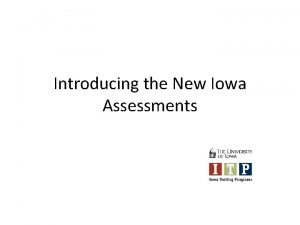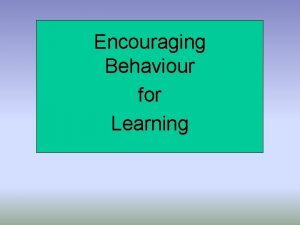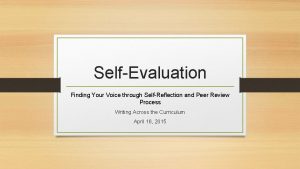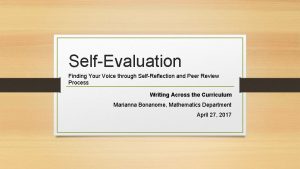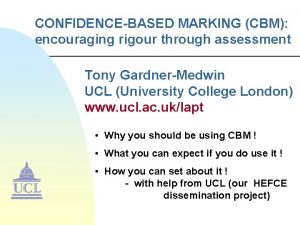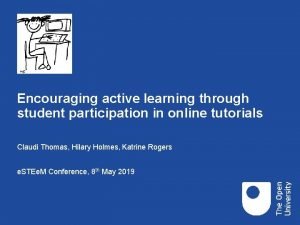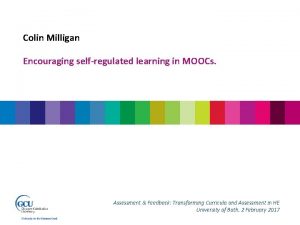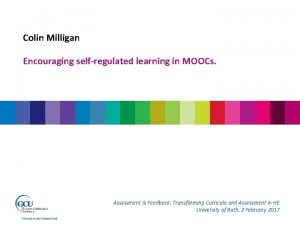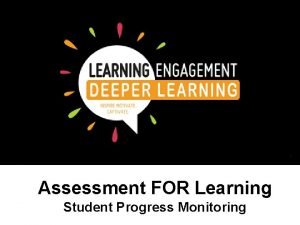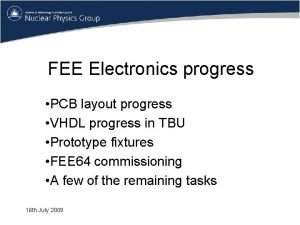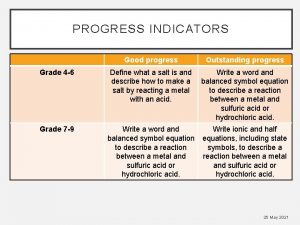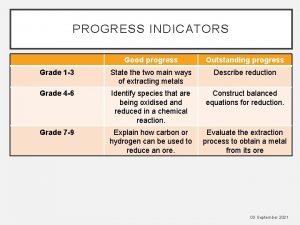Assessment for Learning Encouraging progress through selfreflection and





































- Slides: 37

Assessment for Learning: Encouraging progress through self-reflection and self-evaluation in high ability students: * Evaluative starters and plenaries * Effective peer assessment * Encouraging independent progress through effective teacher feedback QUEEN ELIZABETH’S SCHOOL

Rank the following statements in order of importance. Discuss in pairs and prepare to justify your reasons: (1 being highest 5 being lowest) Why are starters an important part of planning a lesson? Starter activities that demand active engagement and high-level thinking provide pupils with a mental ‘warm-up’ for the lesson. They can enable pupils to connect with prior learning, either to build on what has been learned in previous lessons or to assimilate a new topic or idea. They can enable you to find out what pupils already know and understand. Starters exploit the prime learning time at the beginning of lessons when pupils are often at their most receptive and concentration levels are high. They create a sense of pace from the beginning of the lesson. QUEEN ELIZABETH’S SCHOOL

Starters to help promote high-order thinking QUEEN ELIZABETH’S SCHOOL

Rank the following statements in order of importance. Discuss in pairs and prepare to justify your reasons to the class: (1 being highest 5 being lowest) Why does Lord Capulet feel so strongly about his daughter’s marriage to Paris? He wants to see his daughter married and settled to a man he approves of He wants to be proud of her He wants to have control over who she does or does not marry He wants his daughter to marry a man he chooses: rich, generous, powerful, respected and has status Wedding celebration was intended to raise spirits after the death of Tybalt – Capulet thought it was the right time.

Exploring how Priestley undermines the character of Mr Birling Task: Put the following statements in order of importance. Select strong evidence from the play to justify your views. (1 = highest importance, 5 = lowest). Why is the engagement between Sheila and Gerald so important to Mr Birling? • • • Gerald is the type of man that Mr Birling approves of to marry his daughter. Mr Birling cares about his daughter’s happiness and he believes that Gerald will make Sheila happy. The marriage will benefit Mr Birling’s business through uniting Crofts Limited with Birling and Company. The marriage will boost the social status of the Birlings. Gerald will be an excellent son-in-law for Mr Birling to bond with.

How can you become a water warrior? Collect rainwater for watering the garden Only use the washing machine with a full load Saves most water Take showers rather than baths Make sure dripping taps are turned off Don’t leave the tap on when brushing your teeth Only use the washing machine with a full load Complete the diamond nine showing the ways you think are best to help save water. Use the ideas to help you, but you can add your own ideas too! Saves least water Install your toilet with a dual flush Wash up saucepans by hand rather than use the dishwasher Only boil as much water in the kettle as you need

Using the starter to establish a calm learning environment QUEEN ELIZABETH’S SCHOOL

Establishing a calm learning environment Think about: • Where should boys be looking? At you/the board/at a sheet? • Do you need a written resource? What will it achieve? • Keep instructions short and simple, preferably written down, not just spoken, for clarity.

Establishing a calm learning environment 1. Respond to a sound clip/video (whiteboards) 2. Respond to an image (whiteboards) 3. Quick quiz/check knowledge from homework

Queen Elizabeth’s School Music Department Starter activity You will hear 3 clips of music. Each clip describes a mood or emotion. On your mini-whiteboard, state the MOOD or EMOTION described by each piece of music, and one MUSICAL reason for your answer.

Mood/Emotion Reason(s)

Mood/Emotion Reason(s) EXAMPLE: Happy Major key, allegro staccato

Establishing a calm learning environment 1. Respond to a sound clip/video (whiteboards) 2. Respond to an image (whiteboards) 3. Quick quiz/check knowledge from homework

What links these images?

Minimalism: a twentieth-century movement in music, art and design.

Establishing a calm learning environment 1. Respond to a sound clip/video (whiteboards) 2. Respond to an image (whiteboards) 3. Quick quiz/check knowledge from homework

TRUE OR FALSE: ii 1 Minimalism is a style of music which was in favour in the 1970 s. Minimalism is a style of music which was in favour in the 1960 s.

1 Minimalism is a style of music which was in favour in the 1970 s. Minimalism is a style of music which was in favour in the 1960 s.

Using the starter to motivate learners and stimulate their interest in the lesson QUEEN ELIZABETH’S SCHOOL

First finisher gets a merit (include a 5 minute countdown clock)

Discussion Starters (snowballing)

Starter Challenge! What’s in the box? This half term we will be learning about population – but what country will be our focus? 1 2 3 The teacher will chose and answer 9 questions and reveal a piece of the box 4 5 6 Is this country in the northern or southern hemisphere? 7 8 9 Write down 3 geographical questions you could ask to discover which country is hidden behind the box MERITS: Good questions or correct identification of the country

SAS Read these lines from a poem: Seven of them pinned in blood by long shiny tails, three of them still alive and writhing against the wood, their heaviness whipping the wall as they try to break free Task: Work out what 'seven of them' are. Use specific words to help you.

The title of the poem is: Rattlesnakes Hammered on the Wall SAS How do you think the rattlesnakes came to be hammered on the wall? How does the narrator seem to feel about it? (Not how you feel). How might the poem continue?

WORLD RIVERS: Week 2: The upper course Bell Time: What features of a river’s upper course make it a great place to do outdoor pursuits? !

Starter Challenge! Image a place…! As a part of the Chinese New Year celebrations, the Chinese Embassy in London is running a competition to create an IMAGE OF CHINA. If you needed to draw one picture to represent what you imagine when you think of China, what would it be? TASK You have 5 minutes to draw you geographical image of China. NOTE: It should be an image of a place or landscape…

Starter Challenge! Image a place…! Class review: How many different images were created? Urban / rural? Rich /poor? Agriculture / Industry? Now pass you image to the person next to you. Examine the image in front of you. How does it compare to the image that you created? Is it similar or different? TASK You have 5 minutes to write 3 sentences to describe the image that your neighbour has drawn. EXTENSION: Write one similarity and one difference with the image you created.

Effective Plenaries: • On your own, write down the three most important goals to achieve in a plenary • Swap with your partner and rank which is most important (1 -3, with 1 being most important and 3 being least). Be ready to feed back to the group and justify why you made these choices QUEEN ELIZABETH’S SCHOOL

• At its worst, a plenary can come across as an awkward bolt-on to the lesson: rushed, lost in packing away and setting homework. • Plenary can be lost in a quick ‘what did we learn today? ’ and often pupils will say anything to get out of the room. • The best plenaries are those that form staging posts looking both backwards and forwards, evaluating the learning that’s just taken place and therefore making suggestions about the learning that’s coming next

Did we achieve today’s objectives?


Assessment for Learning: • What are the benefits for peer assessment for students? • What problems have you encountered when planning and delivering peer assessment activities? • What strategies have enabled you to deliver effective peer assessment (and solve some of the problems identified)?

Peer and self-assessment: encouraging independence and motivation for A* • When students assess each other and themselves they encourage a greater responsibility for learning. • Engagement with assessment criteria and reflection of their own performance and that of their peers enables students to learn from their previous mistakes, identify their strengths and weaknesses and learn to target their learning. • Getting students to become more active in their learning in this way can help to alter the perception of learning as being a passive process. If students are participants rather than 'spectators', they are more likely to engage with their learning.

Peer and self-assessment: encouraging independence and motivation for A* • Peer and self-assessment also give students a sense of all the things you have to consider when setting and marking work, helping them to more effectively understand assessment criteria. • Assessment criteria needs to be clearly and fully described so that students are able to understand exactly what is expected of them. • Perhaps stretch students by asking them to contribute to the assessment criteria, transferring even more ownership to the students.

Peer assessment: Feedback is most effective when: • It is focused on the specific learning goal for the piece of work. • It identifies mistakes and clearly indicates where corrections are needed. Impact is greatest when those corrections are completed by the student and checked by the teacher. • Students need time to reflect on the feedback and respond to it. E. g. if mistakes are identified boys could bring them together to write an overview target. Or, students could state how they are going to meet the target by setting tasks to be achieved before the next homework or in a revision checklist before they next have a test on that topic. • Teachers monitor the impact of feedback.

Further ideas for effective teacher feedback: • Ask pupils to re-write one paragraph in the lesson based on the teacher’s written feedback following a marked task. This could be self-assessment to encourage pupils to reflect on their progress. • Create a class tally of the most common targets following a marked piece of work, and discuss/agree steps to address the target with the class. • Ask pupils to write their most recent target at the top of the piece of work that is going to be marked. You could also ask pupils to suggest how they feel they have improved in relation to the target, perhaps through a colour coding system or a brief comment.

Further ideas for effective teacher feedback: • At KS 4 and KS 5, encourage pupils to reflect on how they have improved in their targets over a period of time, through looking back over a cluster of essays and identifying recurring targets or improvement. • Ask pupils to re-do a piece of work if they have not addressed previous targets. • Create a ‘target wall’ on the classroom wall where pupils can record their targets and progress. • If there is a common target given out after marking, the teacher should guide pupils through a collaborative process of modelling a better answer and then get pupils to improve a paragraph based on this.
 Physical progress and financial progress
Physical progress and financial progress Encouragement about giving tithes and offering
Encouragement about giving tithes and offering Through and through sawing advantages
Through and through sawing advantages Iowa state assessments
Iowa state assessments Cuadro comparativo de e-learning
Cuadro comparativo de e-learning Dreikurs
Dreikurs Through one man sin entered
Through one man sin entered Furcation dental definition
Furcation dental definition Night of the scorpion ppt
Night of the scorpion ppt Iso 22301 utbildning
Iso 22301 utbildning Typiska drag för en novell
Typiska drag för en novell Nationell inriktning för artificiell intelligens
Nationell inriktning för artificiell intelligens Vad står k.r.å.k.a.n för
Vad står k.r.å.k.a.n för Varför kallas perioden 1918-1939 för mellankrigstiden
Varför kallas perioden 1918-1939 för mellankrigstiden En lathund för arbete med kontinuitetshantering
En lathund för arbete med kontinuitetshantering Särskild löneskatt för pensionskostnader
Särskild löneskatt för pensionskostnader Personlig tidbok för yrkesförare
Personlig tidbok för yrkesförare A gastrica
A gastrica Vad är densitet
Vad är densitet Datorkunskap för nybörjare
Datorkunskap för nybörjare Stig kerman
Stig kerman Debattinlägg mall
Debattinlägg mall Magnetsjukhus
Magnetsjukhus Nyckelkompetenser för livslångt lärande
Nyckelkompetenser för livslångt lärande Påbyggnader för flakfordon
Påbyggnader för flakfordon Lufttryck formel
Lufttryck formel Svenskt ramverk för digital samverkan
Svenskt ramverk för digital samverkan Lyckans minut erik lindorm analys
Lyckans minut erik lindorm analys Presentera för publik crossboss
Presentera för publik crossboss Vad är ett minoritetsspråk
Vad är ett minoritetsspråk Kanaans land
Kanaans land Klassificeringsstruktur för kommunala verksamheter
Klassificeringsstruktur för kommunala verksamheter Mjälthilus
Mjälthilus Claes martinsson
Claes martinsson Cks
Cks Verifikationsplan
Verifikationsplan Mat för unga idrottare
Mat för unga idrottare Verktyg för automatisering av utbetalningar
Verktyg för automatisering av utbetalningar



